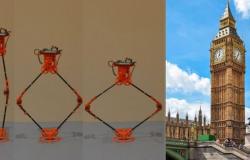Chinese scientists have developed a robot equipped with a laboratory-grown artificial brainwhich can be trained to perform various tasks. The news was reported by the SCMP.
Technology brain-on-chip, created by researchers at Tianjin University and the Southern University of Science and Technology, fuses a brain organoid—a tissue derived from human stem cells—with a neural interface chip. This system allows you to power the robot and teach it to avoid obstacles and manipulate objects. We have a robot that is controlled by real human brain cells, and that makes quite an impression.
This technology represents an emerging field of brain-computer interfaces (BCI)which aims to integrate the brain’s electrical signals with external computing capabilities, an area that China considers a priority. According to Tianjin University, this is the “World’s first open-source brain-on-chip complex information intelligent interaction system”which could lead to the development of computing similar to the human brain.
Ming Dong, vice president of Tianjin University, told the Science and Technology Daily newspaper that a ‘brain’ grown in vitrolike brain organoids, paired with an electrode chip to create a brain on chip. This system encodes and decodes stimulation feedback.
BCI technology has received great attention thanks to projects such as Neuralink, supported by Elon Musk, which consists of an implantable interface designed to allow patients to control devices with just their thoughts. Tianjin University says its research could lead to the development of hybrid human-robot intelligence.
The cerebral organoids they are formed by human pluripotent stem cells, normally present only in the early embryonic stages, which can differentiate into various types of tissues, including neural ones. When transplanted into the brain, they can establish functional connections with the host brain.
The Tianjin University team has published a manuscript in the journal Brain from Oxford University Press, describing how transplanting human brain organoids into living brains is an innovative method to promote the development and function of organoids. Organoid grafts have a functional host-derived vasculature and show advanced maturation.
Li Xiaohong, a professor at Tianjin University, told Science and Technology Daily that although brain organoids are considered the most promising model for basic intelligence, the technology still faces challenges such as low developmental maturity and insufficient intake of nutrients. The team developed a technique that uses low-intensity ultrasound to encourage the integration and growth of organoids in the brain.
Low-intensity ultrasound treatment was found to enhance the differentiation of organoid cells into neurons and help enhance the networks that form with the host brain. This technique could also pave the way for new treatments for neurodevelopmental disorders and repairing damage to the cerebral cortex.
Brain organoid transplants are considered a promising strategy for restoring brain function by replacing lost neurons and rebuilding neural circuits. Furthermore, the use of low-intensity ultrasound on implanted brain organoids could improve neuropathological defects, as demonstrated in a test in a mouse model of microcephaly, a neurodevelopmental disorder characterized by small brain and head size.
The university also highlighted that using non-invasive low-intensity ultrasound treatment could help neural networks form and mature, providing a better foundation for computing. Biological robots made from human cells hold promise for use in medical treatment.
I don’t know about you, but I’m fascinated by robots controlled by neural networks derived from human stem cells, but they’re also very scary. The definition of humanity risks being redefined soon.
Thanks to our Telegram channel you can stay updated on the publication of new articles of Scenari Economici.
⇒ Sign up right away ⇐





